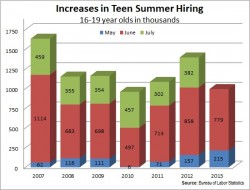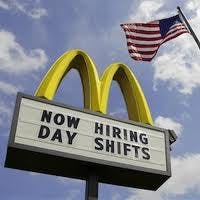A summer job used to be one of those rites of passage for teenagers. Like moving from middle school to high school, and Pop Warner to varsity, working at the local mall, or lifeguarding at the city pool has for many teens become as rare as a drive-in movie.
Though outplacement firm Challenger, Gray & Christmas says the 2013 teen hiring season could still equal last year’s 1.397 million, it would take a July surge not seen since 2010. That July, 457,000 teens between ages 16 and 19 found jobs, a number tempered by such a slow May hiring month that 2010 saw the fewest teenagers in the decade to find jobs.
“In 2010, employers added just 960,000 16- to 19-year-olds over the entire summer hiring period from May through July,” says John Challenger, CEO of the global firm. “Hiring has already surpassed that level this year and, if history is any indication, teen employment is likely to grow by another 300,000 to 400,000 in July.”
2013 hiring numbers far below the peak
The U.S. Bureau of Labor Statistics report for last month’s employment said 779,000 teens got jobs in June. That’s the second strongest June gain since the recession began in December 2007. But, it is far below the 1.114 million of June 2007.
The unemployment rate for 16-19 year olds, which normally rises in June as the kids begin looking for summer work, stood at 26.6 percent last month. On a seasonally adjusted basis, it was 24 percent. Regardless of which number you use, the rate is rivaled only by the worst years of the recent recession.
That’s just part of the story. For the last 10 years, the percentage of 16-19 years even bothering to look for work has been in decline. From 2003 through 2007, the percent of teens participating in the labor force went from an annual, unadjusted rate of 44.5 percent to 41.3 percent. Since then, the rate has dropped sharply, and stood at 34.3 percent last year.
At least since the recession, competition for jobs — any job, including those traditionally taken by teenagers — has become more intense. They find themselves being edged out by recent college graduates, retirees needing to supplement their diminished 401(k)s, and by older workers, unemployed by layoffs and mergers.
Challenger also blames the rise of Internet retailing.
“Another trend,” he says that is hurting teen employment, “is the decline of the American mall, which has long been a traditional employer of teenaged summer job seekers. As more and more Americans flock to the internet for their shopping needs, traditional brick and mortar stores are seeing traffic decline along with the need for extra summer employees.”
